Average Birding

A Winter Trip To Goa
Work's been busy for both average birders this year, and a great deal of holiday needed spending before it was over.
Much research was done to find a warm place with respectable avifauna in November; it's not a month for cheery birding in the UK.
After a brief fling with the idea of The Gambia (ended by the demise of Thomas Cook), we eventually chose to go to Goa.
The Itinerary
We flew direct from Gatwick to Goa, spending a couple of days acclimatising in the capital, Panaji. After that, we travelled to North Goa, to stay on Morjim beach. Finally we travelled to South Goa, staying in Patnem.
Panaji
Having done some research, we had great plans to do extensive exploring (to Carambolim Lake and Chorao Island) and boat trips (along the Zuari), but these got nixed by jetlag in favour of much easier walks around town, and a historical walking tour of Old Goa.
These trundles did yield a few birds. Not least kites - Black and Brahminy are essentially omnipresent; it's hard not to look up and see them at any point in Goa. We were reminded of the frigatebirds in Rio.
The riverfront in Panaji found us a very friendly Common Sandpiper, as well as Indian Pond Heron (well, it was a Squacco Heron to us, until we looked in the book - they are different though, mind), several Egrets (mostly Intermediate), and, in Campal Gardens, the spectacular Indian Paradise Flycatcher (which was, in a bit of foreshadowing for other small tree-based birds, impossible to photograph).
A walk around Altinho found us our first Drongos, and our first Barbet, which easily won the ugliest bird of the trip.
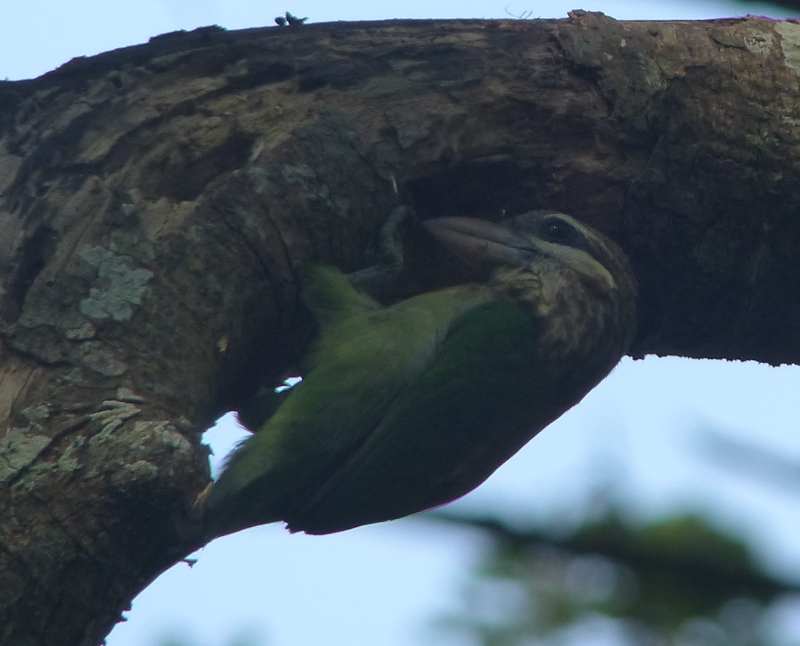
A Red-whiskered Bulbul introduced itself to us on the way back down via a temple or two.

Morjim
After a bargainous 80 rupee bus journey, we arrived in Morjim. Cashback.
Finally free of jetlag, we stomped off to the South end of the beach, to see if there's anything about there. The internet reckons there ought to be. It's a bit mixed; the sand plovers were an absolute delight, but, apart from one fleeting Oriole (probably a female Golden Oriole) and what we guess were Brown-headed and Slender-billed Gulls, as well a Gull-billed Tern (which was, unsurprisingly, a bit of a sod to ID), it definitely verged on quiet. Perhaps we weren't there early enough, or late November isn't the best time.
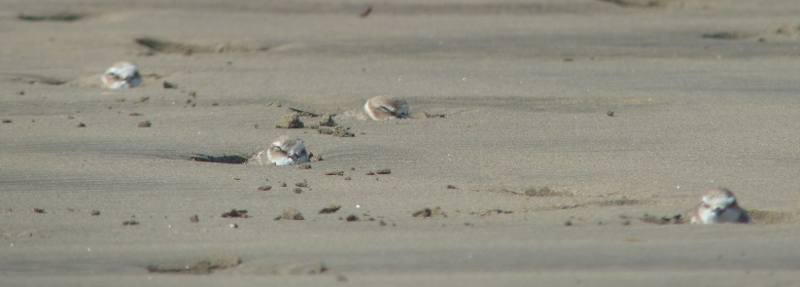
We had better luck on a longer walk North to Mandrem beach; a common sandpiper was threatened by a crab, our first bee-eaters made an appearance (Green), and our raptor radar correctly picked out "uh, that one isn't a kite" with enough time to clap our eyes on White-bellied Sea Eagle (which, true to form, disappeared in seconds once we took our eyes off it).

On the way home, we got an even better look, as a returning Sea Eagle landed in a giant tree, before promptly making a few short flights...into a nest, where its mate then flew down to join it. Great!
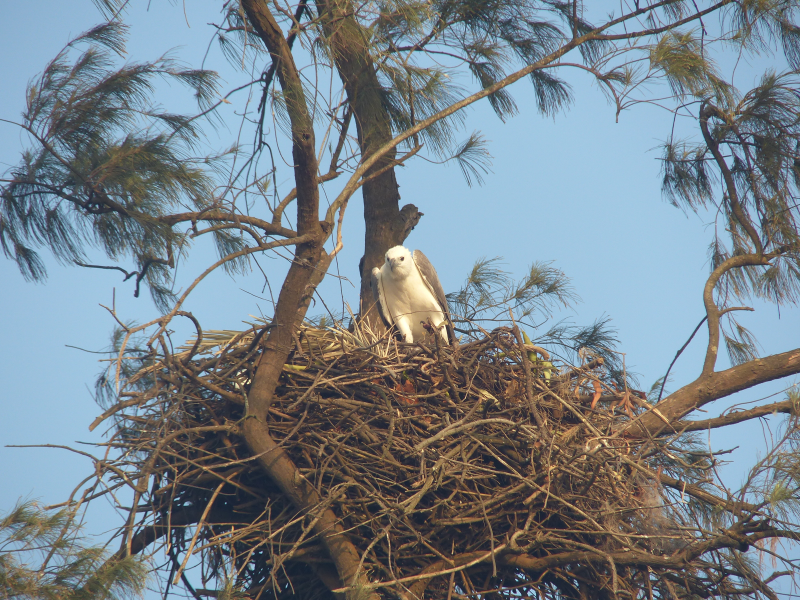
And just as we thought we were done, we finally traced the psittacine shrieking we'd been hearing down to a pair of delightful Plum-headed Parakeets.
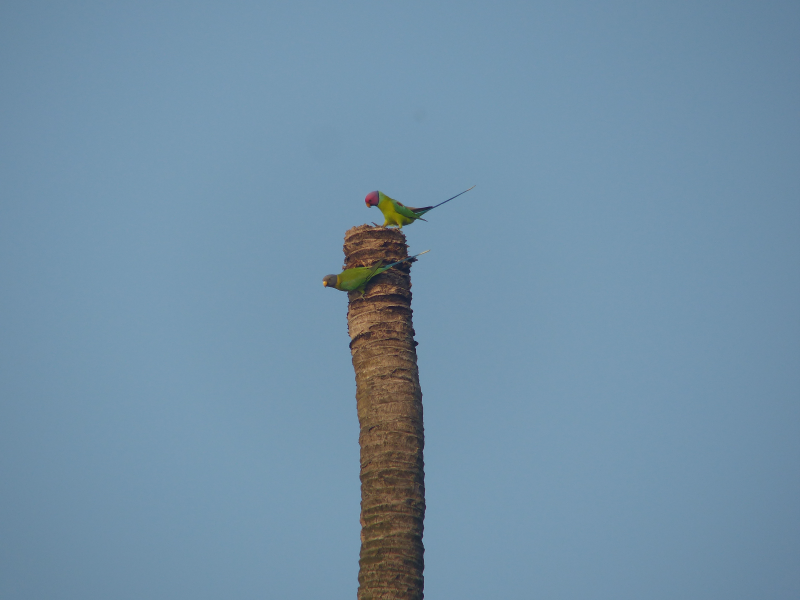
Socorro Plateau
Rahul picked us up early on the 26th, and, after some brief passport pickup shenanigans, we headed to a track up on the plateau. It doesn't take long for things to start happening - the trees are absolutely alive with birds, Rahul is spoilt for choice for things to show us; the highlights are probably Golden-fronted Leafbird (there is such a thing as a leafbird, to our dismay), Racket-tailed Drongo (such noise!), Small Minivet and a female Black-headed Cuckoo Shrike.
Next, we drive down off the plateau into a small wetland area, getting our first good look at White-throated Kingfisher. AB1 gets overexcited and misidentifies a giant cloud of Black-headed Ibis as storks. Eventually some Asian Openbills turn up to spare his blushes.

A Greater Spotted Eagle is spotted hanging around in a distant tree. Nearer the car, what we think is Isabelline Shrike is perched on a spiky bush. Some larger, Blue-tailed bee-eaters are also around and are, frankly, absolutely great. Indian Roller makes a late but fleeting appearance just before we head off. Phwoar.

Cotigao Wildlife Sanctuary
Day 1
Rahul reckons that as the most Southerly and out of the way of Goa's wildlife reserves, this is the quietest and the best. Sounds good to us.
Rahul picks us up from Patnem before 7am, and we're at Cotigao pretty quickly afterwards - this part of the country isn't really awake yet. The plan is pretty simple - we park up next to one of those pivoting gates, and set out for a trundle along a rough track into the forest.
Forest birding. We're less good at this; half of the game is sound here, and we're basically starting from zero on that front. Thankfully, Rahul is excellent on the audio side, and is eager to share - by the end of the trip we start to get to grips with a few of the easier calls.
Even with his help though, we struggle to start with; perhaps it's the windy conditions, but there doesn't seem to be much about.
We reach a clearing, and things quickly improve - the clearing is as busy as the little track up in Socorro yesterday. Quickly, we rack up a new Sunbird (Crimson-backed), Scarlet Minivet, Black-naped Oriole and a surprising number of Fairy Bluebirds, which are great. Greenish Warbler is also a constant companion; amusingly, for Rahul, they are filed under "not so interesting" - he doesn't even hear them anymore, he says.
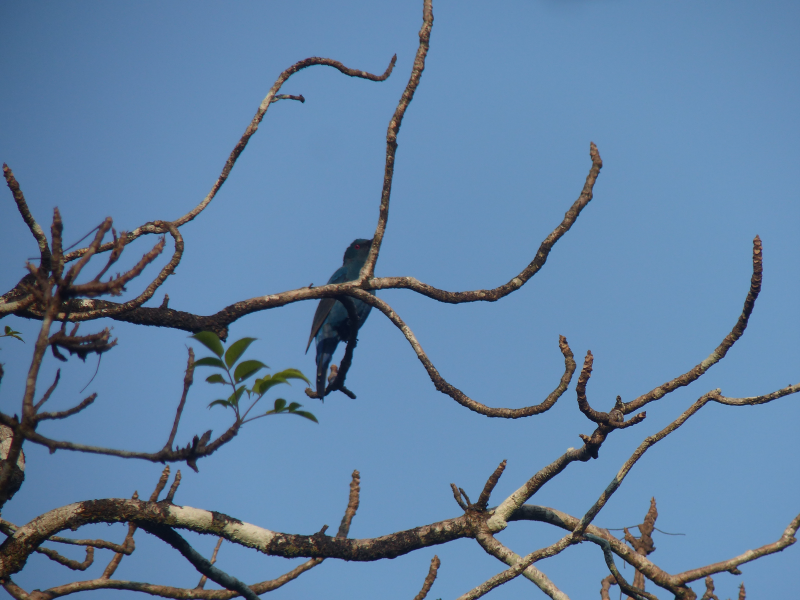
Eventually the clearing, er, clears, and we trek a bit further into the forest. Rahul gets excited - he can hear Crested Serpent Eagle up ahead. Its screechy call continues until it feels like we ought to be on top of it, and after a brief, intensive search, we find it off to our right. Considering the noise it's making, it seems very chilled. Cracking bird.
Just as we turn about, there's a rustling in the undergrowth off to our right again, and we catch a fleeting glimpse of Malabari Grey Hornbill. It's quite remarkable how easily such a large bird can disappear in the forest just by being still; each time we give our eyes a rest, it's a real test to find the bird again. It's worth it though; there's something quite Toucan-like about them in size and manner.
Day 2
Rahul gives us the option of a slightly different walk route, or the same again. After much consideration we decide to stick the the original route - it's quite interesting to bird the same place on two days to see how different it can be. We also get the bonus of Rahul's other half and her daughter coming along too; more pairs of eyes, and more enthusiasm; excellent.
And it is surprisingly different. While Malabari Grey Hornbill was a one-off yesterday, today they're everywhere - flying over, occasionally perching, calling; we even manage a not totally worthless photo of one.

We also hear Malabari Trogon. And it sounds near. Rahul is beside himself - he hasn't seen one on this route for quite a while. Also, it's on the front of our bird book, so it must be good. And we still fondly remember finding a stolid Trogon in the Pantanal. Alas, it isn't to be. Despite a period of intense focus, we can hear the bird moving away without ever seeing it.
Rahul also gets a fleeting glimpse of a Greater Flameback on a dead tree to the left of the track, but by the time we get to him, it's sloped off elsewhere. We resolve to check the same tree on our way back, it has woodpecker written all over it.
We reach the clearing a little later than the day before due to these distractions. An Asian-brown Flycatcher is there to greet us, but other than that, it's a little quieter than it was yesterday. There are still plenty of sunbirds and a few warblers, but not a lot else. An occasional appearance by an Oriole or a Minivet generates more excitement as a result, but it's only when we get up to move on that something new flies through - a pair of Crimson-fronted Barbets.
Further on, we encounter a group of foraging birds, all in a single tree. And, just like a woodland flock can host a range of species back in the UK, so it can here. We rattle through ticks like nobody's business; Grey-headed, Black-crested and Yellow-browed Bulbuls (we've nearly got a full house of Bulbuls at this point), a Velvet-fronted Nuthatch, Brown-headed Barbet, and several sunbirds. The progression of these birds is quite something; just as one species is moving on, another turns up, and then, eventually, things go quiet again.
We're out of time by the time our Bulbul crowd disappates, and so we turn back. Rahul out in front, on a Flameback mission, the rest of us dragging our feet, distracted by Sunbirds.
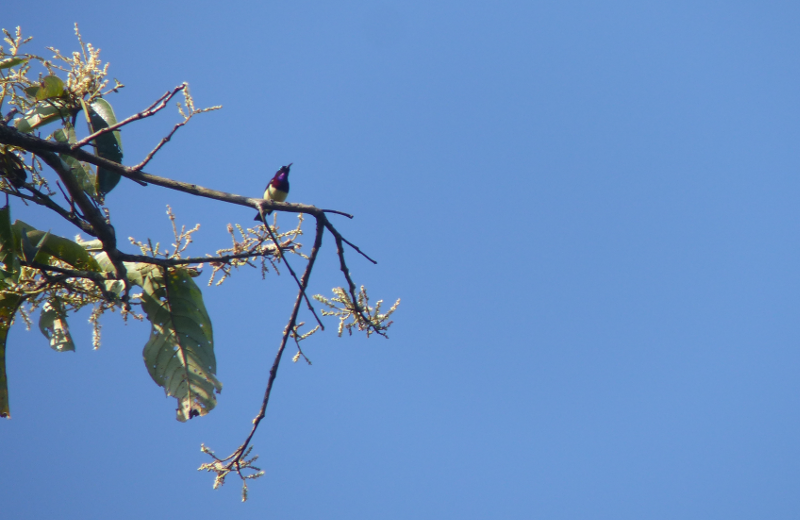
Rahul's mission is a success though - he finds the female Greater Flameback as it switches between a pair of trees either side of the track, and manages to signal what's going on to us without flushing it. It's making its way up the rear side of another dead tree perhaps ten or fifteen metres in front of us.
We wait patiently for it to show itself, but it knows the score, and decides instead to bail massively off to our right (its left?). But in leaving, we get a good view of it, at least. Barring further Sunbird distraction, there ends the forest excitement; Rahul drives us back to Patnem and we thank him for three excellent bits of birding; we wouldn't have found half of that stuff without him!
Rajbag
We've still got a solid couple of days to explore the Patnem area. We start by exploring the beach immediately to the South (Rajbag) - it looks like it is bounded on the South by the estuary of the Talpona, which flows through Cotigao. And there's some decent meandering as it arrives - perhaps there'll be a wader or two to look at. We also noticed a sizable Kite roost in the conifers behind the beach the night before.
We arrive a bit early for the Kite roost, but a treated to another tick in the form of Bank Myna.
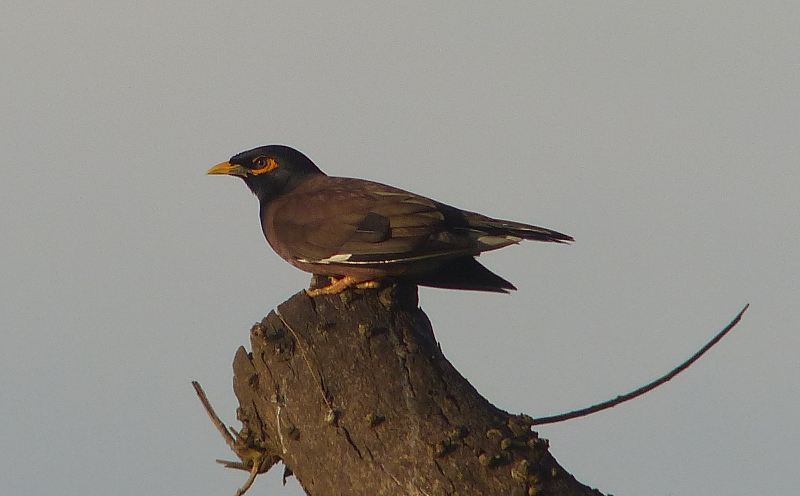
We're also a bit late to get a good look at the estuary, which is a shame, as there's clearly a few decent waders here (and what looks like it ought to be a Terek Sandpiper), but the light's not quite good enough to tell, and it's hard to be sure. Tens of egrets are arriving into a heronry in the mangrove at the centre of the estuary; and a few Ibis also - from their colouration they can only be Glossy. The headland that pokes out from the estuary has a good fifty odd Kites hanging over it though, and we spot two further Sea Eagles and a couple of Marsh Harriers amongst them too.
An excellent spot, which can surely only be improved by getting there a bit earlier.
Turtle Beach and Rajbag again
Encouraged by reports from friends who have stayed here, we arrange to borrow a scooter for the day in order to visit Turtle (or Galgibag) Beach, a little further along the coast. We acquire some extraordinarily good value samosas from the chai shop and head out.
The road quality is dubious, and the navigation somewhat haphazard, but we make it to the beach without incident. AB1 remembers clearly now why he no longer owns a motorcycle, however. The beach, is, effectively, ours - other than a lifeguard or two, it is entirely absent of other people. And it is perhaps a couple of kilometres long. What an absolute treat.
It is not entirely absent of birds - there are several bee-eaters feeding from perches in the conifers at the top of the beach. We have a quick wander to the South end of the beach to check out another estuary (less good - only a Common Sandpiper and yet more Sand Plovers to show for it), before retreating to a shaded area just North of where we parked.
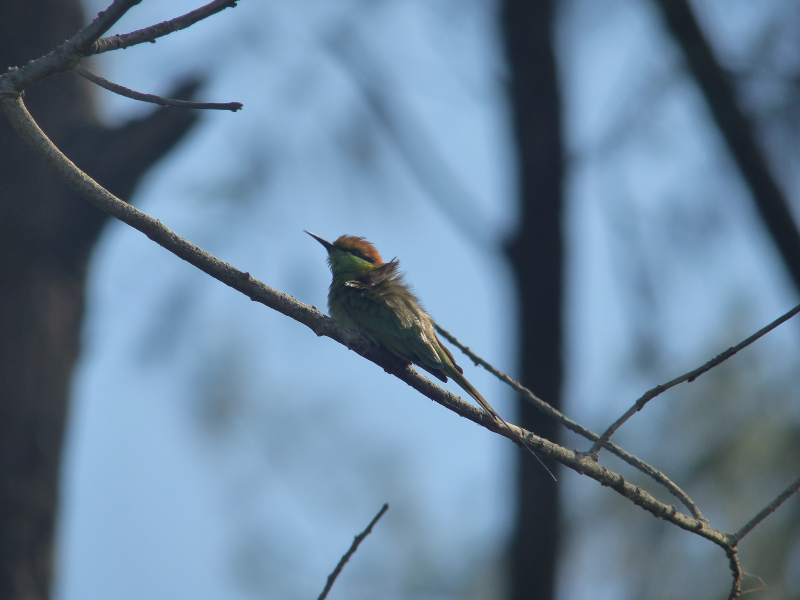
Not a lot happens here. Which is great. We do pick up another tick from the trees behind - Common Tailorbird - but little else appears apart from a few monkeys and we resolve ourselves to the return scooter journey, in order to arrive at Rajbag at an appropriate time.
Return to Rajbag
This time we're earlier. This means we gets some excellent Kite views as we traverse the rocks between Patnem and Rajbag.


It also means that we get an excellent seat for the evening estuary show. A few boat operators attempt to sell us trips we don't want - we politely decline, and, additionally, neglect to attempt to negotiate a trip around the estuary in a rowing boat. Oh for a kayak or two at this point.
Because there are definitely interesting waders on this estuary. And, with a scope, we'd be able to see what all of them are. But the scope, unfortunately, is back in London. So eye strain, terrible record shots and staring at the bird book it is. We eventually convince ourselves that we've got a lot of Redshanks and Sand Plovers, with an additional Terek Sandpiper, and a Greenshank or two.

Before the heronry starts filling up, we decide to see if we can get a bit closer - there's a road that runs along the Northern edge of the river, and we can see there's some places where we might be able to get down to the water from it.
This leads to further distractions - on the non-estuary side; there's a well tended golf course, and its borders harbour some extraordinarily noisy birds. After some work, we resolve that they're a mixture of Myna and Starling, with a few Common Tailorbird and the occasional Bee-eater to keep them company.
After ruling out anything exciting on the golf course, we find a very sketchy route down to the estuary. It's worth it, though - we get excellent views of Striated Heron, Common and White-throated Kingfishers, and, as a bonus. White-browed Wagtail.
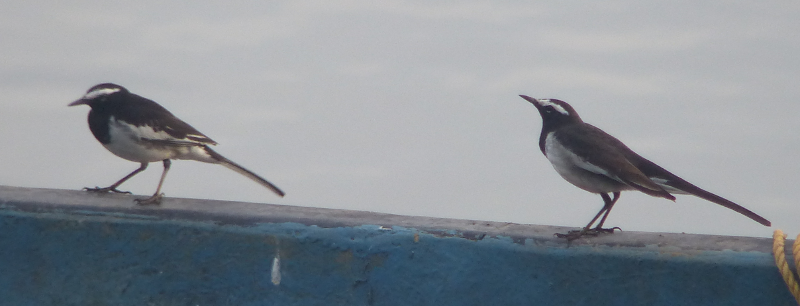
We're also now in prime position to watch hordes of Egrets, Ibis and Openbill come into roost in the mangrove opposite.
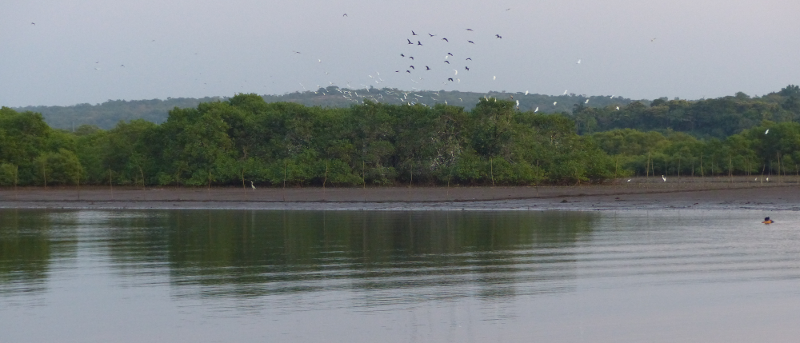
On the way back, we've timed our arrival perfectly for the Kites to be gathering in the tops of the conifers behind the beach. The light's terrible, but it's still great to see them settling in for the evening. We decide to do the same, and head back to Patnem for a belated sundowner.
Bogmalo beach resort
The birding here was surprisingly alright, for somewhere that was chosen entirely on its proximity to the airport.
We had a brief explore of the end of the beach furthest from the hotel, and found a very grumpy Shikra perched in some palm trees, as well as two very friendly Indian Pond Herons.
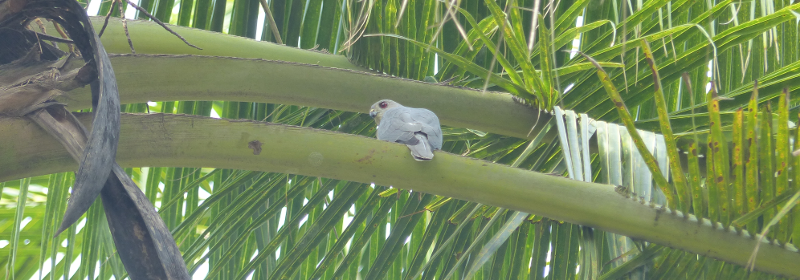
As we circuited the less touristy parts of Bogmalo though, we came across a spring that was full of birds - a few Greenshank, several White-breasted Waterhen, some excellent Kingfishers. In addition, the surrounding woodland was teeming with woodpeckers; we easily saw ten or fifteen. After a bit of work and some truly awful photos, we decided they were Black-rumped Flamebacks. Asian Koel also made a couple of noisy appearances, which drove us nuts, because, until we'd seen it, the whistly call was totally alien to us (which is usually a sign that something seriously interesting is about).
Conclusions
We'd definitely go back. Probably to South Goa, to explore more of the National Parks at that end. And to see Malabari Trogon. And we'll leave more time to get through the airport on the way home (2 hours is not enough...).